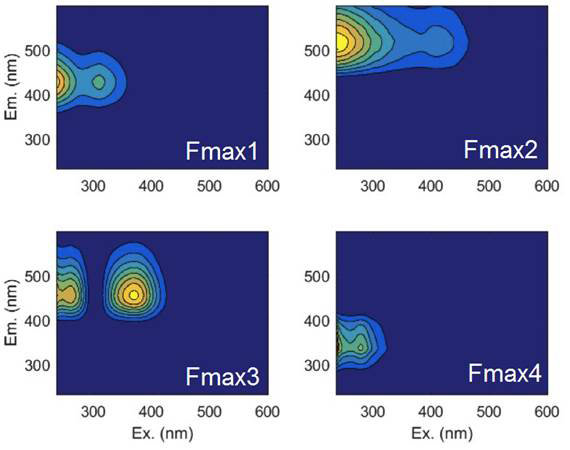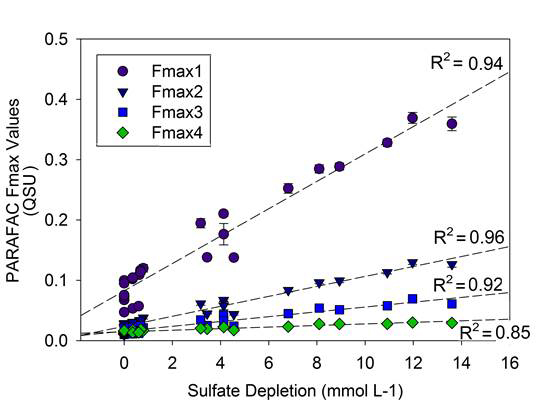Reports: DNI254849-DNI2: Hydrosulfurization of Dissolved Organic Matter in Sediments - Linking Sulfate Reduction and Dissolved Organic Sulfur Formation
Michael Gonsior, PhD, University of Maryland Center for Environmental Science
This project used anaerobic incubation experiments to investigate the incorporation of inorganic sulfur species into dissolved organic matter using ultrahigh resolution mass spectrometry. PI Michael Gonsior, PhD student Jenna Luek, and undergraduate students Kaitlyn Thompson and Sydney Riemer performed the experiments and analyzed data. Three experiments were performed using sediment slurries to investigate changes with varying organic matter and iron; a fourth experiment was performed using seawater inoculated with anoxic sediment bacteria. Excess iron in the sediment slurries created a reaction pathway for the formation of iron sulfide, shunting reactive sulfide species away from reactions with dissolved organic matter. Changes in the dissolved organic compounds were also tracked during the incubation experiments using optical properties measurements, and revealed a direct correlation between anaerobic sulfate reduction and the formation of fluorescent dissolved organic matter. This unexpected and exciting finding has been the focus of conference poster presentations, one undergraduate thesis, and publication in Scientific Reports. Publications based on the specific dissolved organic matter changes revealed using ultrahigh resolution mass spectrometry are in progress, with one final experiment designed to address prior issues is currently underway.
1. Research Outcomes
- Luek, J.L., Thompson, K.T., Larsen, R.K., Heyes, A.H, Gonsior, M. 2017. Sulfate-reducing bacteria produce high levels of chromophoric dissolved organic matter. Scientific Reports 7: 8829. DOI: 10.1038/s41598-017-09223-z
- Thompson, K.T. Sulfate-Reducing Bacteria Produce High Levels of Chromophoric Dissolved Organic Matter. St. Mary’s College of Maryland Senior Thesis.
- Thompson, K.T.1, Gonsior, M., Luek, J.L., Larsen, R.K. Sulfate-Reducing Bacteria Produce High Levels of Chromophoric Dissolved Organic Matter. Poster presented at American Chemical Society National Meeting, Philadelphia, PA. Aug. 2016.
1) presenter *Selected for Sci-Mix poster session. - Thompson, K.T., Gonsior, M., Luek, J.L.1, Larsen, R.K. Sulfate-Reducing Bacteria Produce High Levels of Chromophoric Dissolved Organic Matter. Poster presented at MEES Colloquium, College Park, MD. Oct. 2016.
1) presenter *Best Poster Award
2. Research Methods Overview
2.1 Experimental Design. Anaerobic sediment slurries were used to investigate the relationship between sulfate addition and FDOM production under anaerobic conditions in sediment pore waters. Freshwater sediments were collected upstream of the Conowingo Dam on the Susquehanna River and mixed with varying concentrations of sulfate and acetate to provide optimal conditions for SRB growth. The experiment was carried out under anaerobic conditions using a Coy® Glove Bag, and experimental vials were sampled following the addition of amendments (day 1) and on days 7, 21, and 35. This experiment was repeated using 1) a standard natural organic material (Suwannee River Natural Organic Matter-SRNOM, IHSS standard) amendment and 2) SRNOM and iron (III) oxide amendments. A fourth experiment was performed using 250mL filtered lake water (St. Mary’s Lake Maryland) enriched in DOM using a solid-phase extract of swamp water (Zekiah Swamp, Maryland) and an anoxic sediment inoculate (100uL) from the Chesapeake Bay rather than a sediment slurry.
Filtered samples were analyzed for sulfate, sulfide, DOC, absorbance and EEM fluorescence. Additionally, after weeks 0 and 5, 50 mL samples were solid-phase extracted for analysis using Fourier Transform Ion Cyclotron Resonance mass spectrometry (FT-ICR-MS).
3. Key Findings: Fluorescent Dissolved Organic Matter
During the five-week sediment slurry incubations, sulfate and dissolved organic carbon decreased in all treatments, indicating an active community of sulfate-reducing bacteria. Excitation emission matrix fluorescence (EEM) increased as well during the five-week incubation, and was modelled using Parallel Factor Analysis (EEM-PARAFAC) (Fig. 1). Changes in individual PARAFAC components were highly correlated with sulfate depletion (Fig. 2).
This study provides direct experimental evidence of the production of optically active FDOM material during sulfate reduction and fermentation. Prior field studies have identified an inverse correlation between sulfate concentrations and FDOM intensity. In this study, we simulated the movement of freshwater sediment organic matter through estuarine sediments by altering sulfate availability under anaerobic conditions. Samples were allowed 1-2 weeks to oxygenate following the anaerobic experiment, and fluorescence decreased across all experiments and treatments. However, final fluorescence remained elevated up to five-fold above initial conditions in the Fmax1 component. These results indicate that when anoxic sediments get resuspended or oxygenated from overlying waters, a portion of the newly created FDOM is also likely to be relatively stable under these new conditions. Further details can be found in the peer-reviewed publication mentioned below.
Figure 1. EEM-PARAFAC statistical components Fmax1-4 of fluorescence observed in all samples.
Figure 2. Sulfate depletion versus the intensity of individual PARAFAC components (Fmax1, Fmax2, Fmax3, Fmax4) in quinine sulfate equivalents (QSU) within each sample.
4. Key Findings: Ultrahigh Resolution Mass Spectrometry
In addition to evaluate changes to the sulfur-containing DOM pool, changes in other DOM compounds were also investigated. Samples were first assigned molecular formulas containing carbon, hydrogen, oxygen, nitrogen, or sulfur, and then replicate samples were averaged and log transformed. Hierarchical clustering of FT-ICR-MS organic matter spectral peaks revealed specific patterns over the five-week incubation. Four clear clusters were identified and corresponding Van Krevelen diagrams showing the oxygen to carbon ratio (O/C) versus the hydrogen to carbon (H/C) ratio of the formulas within each cluster are shown in Figure 3.
Figure 3. Hierarchical clustering of Experiment 1 sediment slurry incubation experiment (Week 0 – Week 5). Letter indicates variable sulfate addition treatments (salinity: A=0, B=0.5, C=1, D=5, E=10, F=15) each representing the average of three replicates. Note: Yellow is positive correlation and light purple is negative correlation.
5. Conclusions
We have yet to confirm the incorporation of sulfate-S into the DOM pool, however, we showed that the entire DOM pool is significantly transformed upon fermentation and sulfate reduction. We also showed a direct link between sulfate reduction rates and the production of highly fluorescent DOM, which resembled closely the signals typically found in terrestrially-derived (polyphenolic) DOM.
We published one paper and presented our results at the ACS National Meeting in Philadelphia in 2016.
6. Publications associated with this award
Luek, J. L.; Thompson, K. E.; Larsen, R. K.; Heyes, A.; Gonsior, M. Sulfate Reduction in Sediments Produces High Levels of Chromophoric Dissolved Organic Matter. Scientific Reports 2017, 7 (1).














